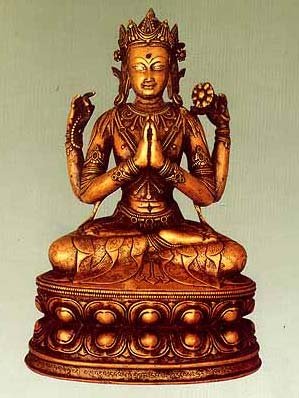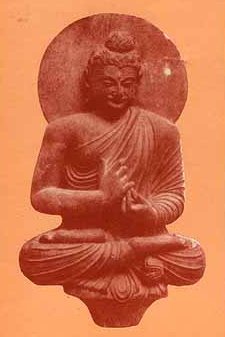Kamabhava, Kāmabhava, Kama-bhava: 4 definitions
Introduction:
Kamabhava means something in Buddhism, Pali. If you want to know the exact meaning, history, etymology or English translation of this term then check out the descriptions on this page. Add your comment or reference to a book if you want to contribute to this summary article.
In Buddhism
Theravada (major branch of Buddhism)
Source: Pali Kanon: Manual of Buddhist Terms and Doctrines'sensuous existence'; s. bhava.
Theravāda is a major branch of Buddhism having the the Pali canon (tipitaka) as their canonical literature, which includes the vinaya-pitaka (monastic rules), the sutta-pitaka (Buddhist sermons) and the abhidhamma-pitaka (philosophy and psychology).
Mahayana (major branch of Buddhism)
Source: Wisdom Library: Maha Prajnaparamita SastraKāmabhava (कामभव) refers to “existence in the world of desire” and represents one of the three types of existence (bhava) according to Mahāprajñāpāramitāśāstra (chapter VI). Accordingly, “By virtue of actions belonging to the domain of the realm of desire, one will be reborn later in this realm to undergo the retribution of these actions (karmavipāka): this is what is called kāmabhava, existence in the world of desire. Mutatis mutandis, it is the same for the rūpabhava and ārūpyabhava. That is what is understood by existence”.

Mahayana (महायान, mahāyāna) is a major branch of Buddhism focusing on the path of a Bodhisattva (spiritual aspirants/ enlightened beings). Extant literature is vast and primarely composed in the Sanskrit language. There are many sūtras of which some of the earliest are the various Prajñāpāramitā sūtras.
Languages of India and abroad
Pali-English dictionary
Source: BuddhaSasana: Concise Pali-English Dictionarykāmabhava : (m.) the sphere dominated by pleasures.
Source: Sutta: The Pali Text Society's Pali-English DictionaryKāmabhava refers to: a state of existence dominated by pleasures. It is the second kind of existence, the first being caused by kamma Vbh. 137. It rests on the effect of kamma, which is manifested in the kāma-dhātu A. I, 223. It is the first form of the 3 bhavas, viz. kāma°, rūpa°, arūpa° Vin. I, 36; D. III, 216; A. IV, 402; Vism. 572. Emancipation from this existence is the first condition to the attainment of Arahantship: kāmabhave asatta akiñcana Sn. 176, 1059, 1091 (expl. SnA 215: tividhe bhave alaggana); Bdhd 61. °parikkhīṇa one who has overcome the desire-existence Dh. 415=Sn. 639.
Note: kāmabhava is a Pali compound consisting of the words kāma and bhava.

Pali is the language of the Tipiṭaka, which is the sacred canon of Theravāda Buddhism and contains much of the Buddha’s speech. Closeley related to Sanskrit, both languages are used interchangeably between religions.
See also (Relevant definitions)
Full-text: Bhava, Trishna, Ditthasava, Kamesana, Kamayoga, Kamatanha, Rupabhava, Arupyabhava, Nandi, Ahsrava, Yuga, Yoga, Rupa, Asava, Tanha, Dukkha, Kama.
Relevant text
Search found 7 books and stories containing Kamabhava, Kama-bhava, Kāma-bhava, Kāmabhava; (plurals include: Kamabhavas, bhavas, Kāmabhavas). You can also click to the full overview containing English textual excerpts. Below are direct links for the most relevant articles:
Dhammapada (Illustrated) (by Ven. Weagoda Sarada Maha Thero)
Verse 415 - A Courtesan tempts a Monk (Sundara Samudda) < [Chapter 26 - Brāhmaṇa Vagga (The Brāhmaṇa)]
Verse 348 - The Story of Uggasena < [Chapter 24 - Taṇhā Vagga (Craving)]
A Discourse on Paticcasamuppada (by Venerable Mahasi Sayadaw)
Chapter 4 - Six Kinds Of Tanha < [Part 6]
Maha Prajnaparamita Sastra (by Gelongma Karma Migme Chödrön)
Part 2 - Explanation of the word ‘mayā’ < [Chapter II - Evam Mayā Śrutam Ekasmin Samaye]
Emptiness 15: Emptiness consisting of non-perception (anupalambhaśūnyatā) < [Chapter XLVIII - The Eighteen Emptinesses]
Part 5 - Pañcamātra Bhikṣusahasra (section of five thousand arhats) < [Chapter VI - The Great Bhikṣu Saṃgha]
The Great Chronicle of Buddhas (by Ven. Mingun Sayadaw)
Part 5 - The Story of Richman’s Son, Uggasena, the Acrobat < [Chapter 22 - Founding of Vesali]
(3) Third Pāramī: The Perfection of Renunciation (nekkhamma-pāramī) < [Chapter 6 - On Pāramitā]
Part 1 - The buddha’s visit to Rājagaha < [Chapter 15 - The buddha’s visit to Rājagaha]
Mahavamsa (by Wilhelm Geiger)
The Mahavastu (great story) (by J. J. Jones)
Chapter XXXVII - The questions of Nālaka < [Volume III]